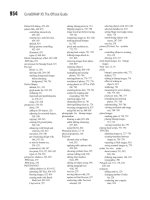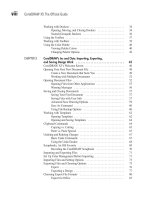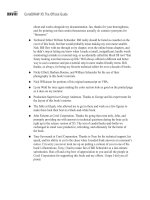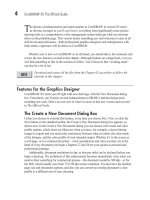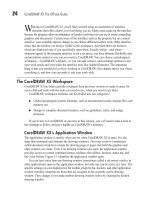CorelDRAW X5 The Official Guide part 9 doc
Bạn đang xem bản rút gọn của tài liệu. Xem và tải ngay bản đầy đủ của tài liệu tại đây (478 KB, 10 trang )
Ill 2-21
When an artist creates art, the most successful pieces are drawn from a generalization to
the specifics, from a coarse outline to filling in the details. Similarly, CorelDRAW deserves
a coarse examination, as covered in this chapter, but as you progress to later chapters, the
details are filled in. You’ve got a general idea of how to navigate in this chapter; it’s time to
move from the interface to the palettes and options you have when building objects, filling
them, and changing them. Chapter 3 sits by your side as you cruise the menus and palettes in
X5; take a guided tour of CorelDRAW’s resources right around the page.
44 CorelDRAW X5 The Official Guide
1
2
3
CHAPTER 3
CorelDRAW’s Ins and Outs:
Importing, Exporting, and
Saving Design Work
45
O
ne of the very first things you learn as a new computer user is how to open and close
files and how to use the Clipboard to copy data from one document window to another.
To accomplish these basic tasks working with CorelDRAW X5, you have nothing new or
exotic to do. But version X5 has additional functions and options, such as file handling and
data import and export, to make your design experience efficient and the results professional.
In this chapter, you’ll learn about file-saving options that let coworkers who are using
previous versions of CorelDRAW work with your files and learn how to use timesaving
templates and other file types. You’ll also see how to protect your work with CorelDRAW’s
automatic backup feature, how to make the Clipboard work overtime for you, as well as how
to store and retrieve scrapbook items and symbols and how to import and export graphics,
text, and data into and out of CorelDRAW.
Download and extract all the files from the Chapter03.zip archive to follow the
tutorials in this chapter.
CorelDRAW X5’s Welcome Screen
When CorelDRAW opens, the Welcome/Quick Start tabbed screen appears, where you can
quickly open a new or existing drawing file, access learning tools, check for program
updates, and set automatic checks for program updates. You can also view the latest gallery
of art created by fellow CorelDRAW designers. This launch pad is shown in Figure 3-1.
The first tab along the right edge, Quick Start, is your jumping-off point for opening a file.
Here, in the Open Recent section, you are presented with a list of the last files you opened and
closed in CorelDRAW. Hover over the name of one of these files, and a thumbnail preview
for that file appears along with the document information. Click the name of the file, and the
Welcome dialog closes, and the file you selected opens. If you want to open an existing file
that is not among the five most recent files you’ve opened, click the Open Other button to close
the Welcome screen page and to open a standard Open Drawing dialog.
To start a new drawing document from the Quick Start tab, go to the Start New section,
and click the New Blank Document link, or click the New From Template link if you want
to create a document from one of the special design layouts that ship with CorelDRAW or
from a template you previously created.
The other tabs lead you to the following areas of interest:
●
From the What’s New tab, you can click your way through the CorelDRAW New
Features Tour slideshow.
●
The Learning Tools tab contains links to launch documentation from your hard disk
such as CorelTUTOR, and Insights From The Experts as well as a link to Corel’s
online learning resources. If you purchased the DVD of the CorelDRAW install
instead of the electronic download version, you can also easily access the tutorial
videos from this page.
46 CorelDRAW X5 The Official Guide
●
The Gallery tab displays a changing selection of artwork created in CorelDRAW. It
also contains a link to the CorelDRAW.com Community page, where you can create
an online gallery of your artwork for the world to see and enjoy, participate in online
forums, and download helpful files like custom media strokes, textures, and macros.
●
The last tab is the Updates tab. At the top of the tab window is the word “Settings.”
If you click this link, the Update Settings dialog opens. It contains two options that
are turned on if the box next to the option is checked, or turned off if it is unchecked.
Your choices here are “Notify me of available product updates, news, and tutorials”
and “Automatically download product updates and ask me before installing.” These
are useful and helpful options to keep up to date both your copy of CorelDRAW and
your knowledge of things related to CorelDRAW.
CHAPTER 3: CorelDRAW’s Ins and Outs: Importing, Exporting, and Saving Design Work 47
3
FIGURE 3-1 CorelDRAW welcomes you with a tabbed launch pad after loading.
Preview Access Learning ToolsLast saved/opened files
Enable/disable Welcome
screen at startup
Open file not listed New file based on template
Updates
If these boxes are checked (they are by default), every time you start CorelDRAW it will
access your Internet connection in the background and check in with the Corel website to see
if any updates or files should be downloaded for you. So don’t be alarmed if your computer’s
firewall software pops up a notice that CorelDRAW is trying to access the Internet. If
CorelDRAW displays a message that it could not find an Internet connection, you will
probably have to open your firewall software and give CorelDRAW permission to access the
Internet. If you don’t want CorelDRAW checking the website every time you start CorelDRAW,
uncheck both of these boxes, and then click the close box in the corner of the Update Settings
dialog to apply the changed Updates option settings.
If you don’t want to use the features offered by the Welcome screen, click the close box.
To never see the Welcome dialog again, click to uncheck the “Always show the Welcome
screen at launch” check box. To open the Welcome screen at any time, choose Help |
Welcome Screen, or click the button directly to the left of the zoom percentage field on
the standard toolbar.
Opening Your First New Document File
If you are not using the Welcome screen, choosing File | New (CTRL+N) or clicking the New
button on the standard toolbar, shown here, opens the Create a New Document dialog, where
you choose the settings such as color space and document resolution, and can also choose
not to display this dialog in the future. If you check “Do not show this dialog again,” new
documents are based on the current settings. If you do want to see this box again because the
default settings aren’t right for your type of work, click the Options button on the standard
toolbar, and then under Workspace | General, check the “Show New Document dialog box”
check box.
Ill 3-1
48 CorelDRAW X5 The Official Guide
Open a new
document
Create a New Document that Suits You
The Create a New Document dialog, shown next, is new to version X5, and although new
users might feel a little intimidated by the number of options, it’s really quite straightforward
to use and to set up a page that reflects your intended output. Here is a brief explanation of
the fields and what you choose depending on your printing and export needs:
●
Name You don’t have to wait until you save a file to name it. By default, a new
document is named “Untitled-1,” using a sequential naming pattern—your next
document in a session of CorelDRAW is named “Untitled-2,” and so on. It’s fine to
accept the default name, but it’s a better idea to name the file now if you know what
you’re going to create.
●
Preset Destination “Destination” refers to where the file is ultimately going: to
commercial printing, to the Web as an HTML page or graphic…you have five
choices here in addition to Custom. If you want to set up a Rendering Resolution
or Color Settings entirely of your own choosing, Preset Destination will automatically
CHAPTER 3: CorelDRAW’s Ins and Outs: Importing, Exporting, and Saving Design Work 49
3
call your settings “Custom.” If you want to keep and reuse the existing page setup,
click the Save button (the diskette icon) to the right of the drop-down list and name
the preset. The next time you create a new document, you can choose your preset
from the drop-down list and spare yourself defining any other field in this dialog.
●
Size Define the page size you need by choosing from the large selection of preset
page sizes, or set your own custom size by typing values into the Height and Width
fields below it. Also, next to the Height field, click an orientation icon—portrait or
landscape—for your new document.
●
Primary Color Mode You have your choice of RGB or CMYK. If you choose
CMYK, the Color Palette’s color wells will look duller than you’d expect, because
CMYK color mode is print legal—CorelDRAW simulates what the colors you use
for object fills will look like when printed, because certain colors you see onscreen
cannot be faithfully reproduced using printing inks and other pigments. If you are
designing for the Web, choose RGB from the drop-down list. Also, if you are
designing for a personal home inkjet printer, choose RGB. Although inkjet printers
use cyan, magenta, yellow, and black pigments, today’s inkjets have conversion
circuitry that takes—and actually expects—RGB data and automatically converts it
to fairly closely matching CMYK-equivalent colors.
●
Rendering Resolution Although CorelDRAW is a vector-drawing program, and
as such produces resolution-independent vector shapes, you will want to choose a
Rendering Resolution that is best for any CorelDRAW effect that is rendered as a
bitmap when you print or export your file to a format other than CorelDRAW’s
native CDR file format. For example, if you’ve created a drop shadow on an object
and intend to print your file to a high-resolution image-setting device, image setters
at commercial print houses usually expect 266 to 300 ppi (pixels per inch, frequently
called dpi, dots per inch)—so you’d specify 300 dpi to ensure a smooth rendered
drop shadow. If you’re printing to a home inkjet, effects can look good at lower
resolution settings such as 225 to 260 dpi. Rendering Resolution has no bearing on
files you export to bitmap format via File | Export; the resolution for exporting to
JPEG, TIFF, and other image formats is set in their Export dialogs.
●
Preview Mode There is little reason to specify anything other than Enhanced for
previews. If you choose Draft or Wireframe by accident, this is easily changed by
choosing Enhanced from the View menu when your document is open.
50 CorelDRAW X5 The Official Guide
●
Color Settings If you’re concerned about color consistency while you work (hint:
you should be!), this is one of the new features in version X5. (By default, this area
is “rolled up.”) Windows offers color management in the form of ICC profiles that
are located in your Windows | System32 | spool | drivers | color folder. Color
profiling is a method by which you can increase your odds that what you see on your
monitor is represented in a color print you make. Three components use color
management: your monitor (which you calibrate using third-party software,
hardware you can buy, or Windows Control Panel settings for your video card); your
application (which is CorelDRAW, and here is where you tell CorelDRAW which
color profile to use when it imports and how to tag images when it exports); and
your printer (most printers today understand color management and have settings
you manage through a proprietary control panel or through Windows Printer
options). If you’re a home-printing or Web-designer sort of person, note that most
users access one or two RGB color profiles. sRGB is used by many home inkjet
printers and digital cameras, so sRGB is a safe color setting to ensure consistent
color output from what you see onscreen, what your photos look like when you
import them to CorelDRAW, and when you print your work. Many designers own
more than one application, and as a result, it’s hard not to accumulate color profiles
that other applications installed, perhaps without your realizing it. Scroll down the
list of color profiles in the color folder: if you see CIE RGB or Adobe RGB, you
might want to use it as your color setting. Adobe RGB is an optimized version of
CIE RGB—color profiles “live” in something called a color space—an area of the
visible spectrum within which certain colors can be expressed while those outside
this area cannot. CIE RGB color occupies a greater color space than sRGB. If you
deal with delicate shades of color and you need great control of a precise color, such
as in fashion design and corporate logos, CIE RGB gives your document a much
larger color space than sRGB.
Rendering Intent is used when importing and exporting an image or other bitmap
graphic that has been tagged with a color profile: CorelDRAW X5 can both read
and write information into the header of a bitmap that tells the application
importing it how to handle color data. Often, the color space of a bitmap you
import to a page either doesn’t have a compatible color profile, or the image is not
tagged with a color profile at all. Relative Colorimetric is the default option for
reassigning imported images the color space of the file you’re working on, and it’s
probably the best choice for most images. Relative Colorimetric compares the
brightest areas in the imported image’s color space to those of the destination color
space (your document) and shifts all colors to fit within the color space. Out-of-
gamut colors, colors that cannot be expressed in your CorelDRAW document’s
assigned color space, are shifted to the closest color in the destination color space,
thus preserving more of the original colors in an image than the Perceptual option,
which would be a good second choice if the colors in the imported or exported
image look wrong.
CHAPTER 3: CorelDRAW’s Ins and Outs: Importing, Exporting, and Saving Design Work 51
3
Working with Multiple Documents
Like many graphics applications, CorelDRAW can keep more than one document open in
the interface. Each open document, whether it is new or is a previously created document,
is listed at the bottom of the Window menu. If you’ve opened several documents, you might
notice that each document window is maximized, but only the most recently opened document
appears in view, indicated by the document default name in CorelDRAW’s application title
bar. This is because while document windows are maximized, only the document in the
forefront is visible. Any other opened documents are hidden from view. To navigate between
document windows in the maximized state, choose Window | Filename, as shown here.
Ill 3-3
To see all open document windows and automatically arrange them in your
CorelDRAW application window, choose Cascade, Tile Horizontally, or Tile
Vertically from the Window command menu.
Opening Document Files
To open an existing document, choose from one of these three actions: click the Open Other
button from the Welcome screen, click the Open button in the standard toolbar, or choose
File | Open (
CTRL+O). In any case, the Open Drawing dialog appears, as shown in Figure 3-2.
The Open Drawing dialog is mostly a standard Windows 7 configuration with some
interesting and useful CorelDRAW additions. You can choose different-sized icon views
of documents, and CorelDRAW files do indeed display graphical thumbnails of your saved
52 CorelDRAW X5 The Official Guide
work. Also, an application identifier tick at the bottom right of the icons lets you instantly
tell that a folder contains either CorelDRAW files or Corel Presentation Exchange (CMX)
documents. Additionally, if you click the All File Formats drop-down arrow, a comprehensive
list of all the file types CorelDRAW can open appears; this is a handy way to filter out file
types when you’ve opened a folder containing CorelDRAW files, video, and audio files, for
example. To open a file, click its title or icon, and then choose Open. If you’ve recently
opened a CorelDRAW-supported file type, you can click the down arrow to the right of the
selected File Name, and you can choose from a list of CorelDRAW files from all over your
hard drive.
CHAPTER 3: CorelDRAW’s Ins and Outs: Importing, Exporting, and Saving Design Work 53
3
FIGURE 3-2 The Open Drawing dialog in CorelDRAW is an enhanced version of the standard
Windows Open dialog.
Windows view
File list
Selected file
List of recently opened files
Filter for file types
CorelDRAW can open
Code page
